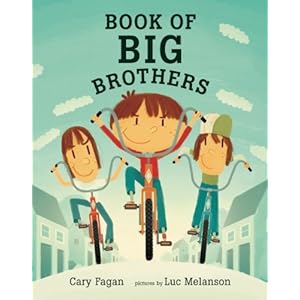Illustrated by Luc Melanson
(Groundwood Books, 2010)
I don’t usually go for endearing
when I’m picking out books about siblings.
Experience tells me bratty and
annoying lead to funnier reads. But I’ve groaned when reading a few recent
books that feature pesky siblings.
Sometimes it’s just too much.
Perhaps that’s part of the reason I kept reading Book of Big Brothers when it became clear from the first pages that
the book was a tribute to older siblings rather than a platform to humorously
disparage them. The real reason that I
persevered, however, is due to the author.
Cary Fagan wrote one of my all-time favorite picture books, the
utterly delightful Thing-Thing. For me, anything he writes deserves a
read.
There is a sense of nostalgia that comes from reading this
book. I may not have had such endearing
moments growing up with my siblings, but it is nice to think Fagan—or
anyone—may have. Jerry Spinelli masterfully
evoked nostalgia regarding his childhood in Knots
in My Yo-yo String: The Autobiography of
a Kid and Fagan’s Big Brothers ably
takes the baton handoff.
The story begins with the boy narrator relating the story of
his arrival home from the hospital after birth.
His two older brothers drop him—not due to being cloddish or evil
imbeciles but on account of their excitement to be the first brother to hold
the newest member of the family. The
anecdotes of the boys’ growing up together lack incidents of teasing the baby
brother. (Indeed, there is one tale of
the youngest having the upper hand on them.)
Fagan’s storytelling is as appealing as ever. Take this description of when the narrator
had to stay home sick on a school day:
At recess time I could
hear the kids shouting in the school yard.
The afternoon dragged on and on.
It felt like the whole world had forgotten me.
Yes, it’s a far car from “Ferris Bueller’s Day Off”. Endearing, to be sure.
Fagan goes on to portray the big brothers as protectors,
entertainers, death-of-a-pet consolers and sparkly-ideas-gone-wrong
co-conspirators. Many a parent will read
this book and find it a pure work of fiction.
I can picture a mother or father giving the book a bedtime read, sitting
between two siblings and interjecting, “Now why can’t you two be like
that?!” But in most homes, even my own,
there are (were) such moments. Sometimes
we just have to jog our memories a little more.
Luc Melanson’s illustrations add to the nostalgic feel with
a heavy dose of muted greens, blues and reds.
The humans are simplistically drawn in sharp contrast to some of the
realism that pops up in furniture, a shoe tread and a Lego robot.
The text is far longer than most of the current crop of
picture books. I’ve attended conferences
and heard agents and editors continue to lower the word count maximum for
picture books: 1,000…800…500. Yes, these limits make the slush pile more
manageable, but I am glad that Groundwood Books allowed the author the chance
to tell the whole story rather demanding the equivalent to a highlight reel.


ReplyDeleteHi, can i ask you something? I’m looking for children books with “scary” animal illustrations like the big bad wolf (or a fox) eating pigs (or seven kids or Red Riding hood or birds in Chicken Little) or being pictured with a fat stomach. Could be any other animal as well. Have you seen any book of this sort? Any sort of help is appreciated. Thanks in advance.
Great blog, by the way!
nelly